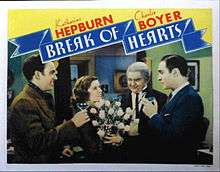Break of Hearts
| Break of Hearts | |
|---|---|
 Lobby card | |
| Directed by | Philip Moeller |
| Produced by | Pandro S. Berman |
| Written by |
Lester Cohen (story) Victor Heerman Sarah Y. Mason Victor Heerman |
| Starring |
Katharine Hepburn Charles Boyer |
| Music by | Max Steiner |
| Cinematography | Robert De Grasse |
| Edited by | William Hamilton |
Production company | |
Release dates |
|
Running time | 78 min. |
| Country | United States |
| Language | English |
| Budget | $427,000[1] |
| Box office | $695,000[1] |
Break of Hearts is a 1935 RKO film starring Katharine Hepburn and Charles Boyer. The screenplay was written by the team of Sarah Y. Mason and Victor Heerman, with Anthony Veiller, from a story by Lester Cohen, specifically for Hepburn.
Boyer played Franz Roberti, a passionate and eminent musical conductor; Hepburn was Constance Dane, an aspiring but unknown composer. She wants to see his concert, but it is all sold out. When she sneaks into his rehearsal he is smitten by her devotion and gets his orchestra to get it right as they play just for her. Constance marries Franz: he says she is "a most exciting creature" and she has been in love with him for a long time (i.e., "since late this afternoon").
Not long after they get married Constance finds Franz having dinner with a female friend. So Constance responds by going out with her own friend, Johnny Lawrence (John Beal). Johnny wants to marry Constance, but she cannot forget her husband. Franz has been hitting the bottle and pretty much throwing away his career, although exactly which of his many sins is driving him to drink is not really clear. Fortunately, Constance has been working on her concerto.
The best part of this film, directed by Philip Moeller, comes at the beginning before Franz and Constance get together. The rehearsal sequence has a certain charm, but Franz's interest in Constance is never really believable. The story does have some parallels with A Star Is Born but the result is one of Hepburn's least successful efforts at RKO.
Originally Break of Hearts was intended as a vehicle for Hepburn and John Barrymore. The film was promoted by RKO's advertising department with the catch phrase: "The star of a million moods together with the new idol of the screen." (Francis Lederer actually was first signed-up lead, but the producers replaced him with Charles Boyer.)
Reception
Writing for The Spectator, Graham Greene praised the acting of Boyer and Hepburn which he described as "talented enough to keep some of our interest even in a story of this kind". Concerning Hepburn in particular, Greene noted that she "always makes her young women quite horrifyingly lifelike with their girlish intuitions, their intensity, their ideals which destroy the edge of human pleasure".[2]
This film made a slim profit of only $16,000.[1]
References
- 1 2 3 Richard Jewel, 'RKO Film Grosses: 1931-1951', Historical Journal of Film Radio and Television, Vol 14 No 1, 1994 p56
- ↑ Greene, Graham (13 September 1935). "On Wings of Song/Peg of Old Drury/Break of Hearts". The Spectator. (reprinted in: John Russel, Taylor, ed. (1980). The Pleasure Dome. pp. 20–22. ISBN 0192812866.)